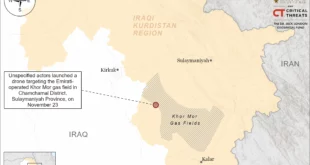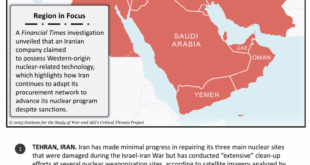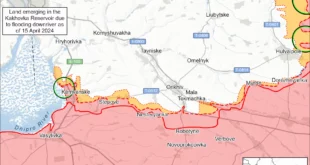The fall of Assad’s regime, while ostensibly surprising for many, was quite predictable. Syria’s economy had been devastated by more than a decade of war, compounded by sanctions that crippled state infrastructure and left 90 percent of Syrians below the poverty line. Moreover, state subsidies on essentials such as food and fuel were slashed over the last few years, worsening the humanitarian crisis and fuelling renewed public dissent.
In addition, the regime’s military backbone had also been hollowed out by years of attrition. The Syrian army, depleted by the loss of over 100,000 soldiers since 2011 due to sustained combat losses, desertions, and defections, severe morale issues and resource shortages, exacerbated by constant Israeli strikes targeting its bases. This contrasted with the rebel groups that were effectively training, mobilising, and recruiting troops over the last few years before they launched their offensive.
Hezbollah, a key pillar of support for Assad during the civil war, had also been severely weakened. Even as it maintained its reputation as a capable resistance force, Hezbollah found itself overstretched, diverting resources to assist Hamas in Gaza and countering Israel’s aggressive actions. This decline underscored Iran’s diminishing ability to shield its regional allies as it contended with its own challenges amid escalating tensions with Israel and resource limitations. Meanwhile, Assad’s other primary ally, Russia, found itself embroiled in a prolonged conflict in Ukraine, which drained its military and financial resources. Yet, questions remain on the challenges of putting together a credible post-Assad government with the experience required to reconstruct and repair the war-torn nation.
A legacy of repression: The roots of today’s challenges
The violence of the Assad dynasty not only obliterated Syria’s political life for decades but also laid the groundwork for the challenges faced today. Hafez al-Assad’s legacy of systematic repression, epitomised by the 1982 Hama massacre in which 40,000 people were killed, organised dissent by groups like the Muslim Brotherhood—the only existing political opposition to the regime was eradicated, and authoritarian control was established. His policies extended beyond violence, banning the Kurdish language and cultural expressions to enforce Ba’athist unity under the guise of Arab secular socialism. The Mukhabarat, Assad’s feared intelligence apparatus, added another layer of repression, conducting mass arrests, torture, and executions without oversight. Dissent was crushed before it could take root, as emergency laws allowed arbitrary detentions and a climate of fear to prevail. This suppression ensured a smooth transfer of power to his son Bashar in 2000, but left Syria with no infrastructure for meaningful political opposition.
Today’s fractured and externally-backed Opposition is a direct consequence of nearly half a century of calculated repression by the Assad regime. By systematically dismantling all forms of political organising and expression, the regime left the Syrian people metaphorically orphaned when it comes to political movements and leadership.
Consequently, the Opposition that has emerged is dominated by two key groups: Hay’at Tahrir al-Sham (HTS), an Islamist faction that evolved from the Al-Nusra Front, and the Syrian National Army (SNA), formerly the Free Syrian Army, backed by Türkiye. HTS operated in northwest Syria, where it sought to consolidate its influence, while the SNA focused on combating Kurdish forces along the northern border. Despite tensions and divergent objectives, these groups have temporarily united against the regime. However, due to a lack of domestic infrastructure such as political know-how, finance and experience, any political opposition be it a political party or a rebel group is beholden to affiliating either with extremist groups or will remain vulnerable to being co-opted by international backers to survive.
International powers and their engagements in Syria
Against the backdrop, it is pertinent to examine several nations’ roles regarding how Syria may be governed in the future.
Firstly, Türkiye, being Syria’s immediate neighbour and the primary backer of the anti-Assad opposition since the start of the civil war, has announced its intention to play a role in ensuring Syria’s stability. Not only will the rebuilding of Syria give Türkiye new economic opportunities, but it will also allow Syrians displaced in Türkiye to return to their nation—an important win for Erdogan since their presence has led to domestic tensions. Moreover, peace in Syria solves a major security problem for Türkiye, particularly its longstanding Kurdish issue. Türkiye’s motivation to address the Kurdish threat has been so strong that it even sought reconciliation with the Assad regime over the past few years, only to be rebuffed by Bashar and his government. In shaping Syria’s future, Türkiye may also align with Qatar, another key supporter of Arab uprisings, to back the new Syrian regime. Qatar’s history of supporting transitions away from authoritarian rule, coupled with its financial and regional influence, could bolster Türkiye’s efforts in stabilising Syria.
Secondly, while Iran has been a close ally of Assad-led Syria, it has suggested that Syria’s future should now be determined by Syrians themselves. This stance came in the wake of the rebel group HTS announcing it would not target Shia shrines valued by Iran in Syria. Nevertheless, with US sanctions on Syria unlikely to be lifted, Iran, alongside Russia, may likely continue to back the new government, too. Despite Assad’s fall, Israel has already begun attacking the newly freed Syria, signalling dissatisfaction with the regime change and the regional disruption it creates.
This dynamic could lead to a natural alignment between Russia and the rebels. Russia’s military bases in Syria could entice it to engage with the new Syrian government to safeguard its interests in the region while offering protection to the rebels from Israel. Iran, meanwhile, could continue arming groups resisting Israeli occupation as it did when Assad was in power. The rebels themselves, especially given their alignment with groups like Hamas, may find ideological common ground with these actors. Khaled Mishal, the leader of Hamas, was notably supportive of the Syrian revolution in its early days, further strengthening this potential connection. This would be dependent on them deciding to engage with Iran and Russia, their former enemies. Examples of the rebels forgiving compulsorily conscripted military personnel suggest that it may take a forgiving/realpolitik approach to its former enemies, including Russia and Iran, to ensure that it continues to have international military backing.
Thirdly, for the US and Israel, the fall of Assad presents both opportunities and risks. Israel, which celebrated the fall, may see this as an opening to target Hezbollah and Hamas supply lines, as well as to consolidate its hold over the occupied Golan Heights. However, the rebel factions now in power could pose a renewed challenge to Israel if they strengthen over the medium term. US allies, Saudi Arabia and the United Arab Emirates (UAE) are also closely watching developments. Both nations have used Syria as a cautionary tale against revolutionary change and are likely to take steps to ensure that the situation in Syria does not embolden opposition within their own borders.
The US’ interests in Syria itself are twofold; first, it will want to prevent ISIS from resurging, as seen in its bombing of several ISIS bases after the fall of Assad. Second, it will want to ensure that the new government will not attack Israel, possibly preparing for retaliation if they do. On a third, additional possibility, if Russia and Iran were to re-establish their presence in Syria, then the US could potentially look at Syria as a continued challenge.
Clearly, historic processes beginning with Hafez al Assad in the 1970s have played a significant role in current-day rebel groups engaging in transnational alliances to survive. As the euphoria of the Syrian people winds down, they now face the dual challenges of rebuilding their nation amidst a fractured political infrastructure and ensuring that external powers do not have disproportionate influence over their future.
 Eurasia Press & News
Eurasia Press & News



